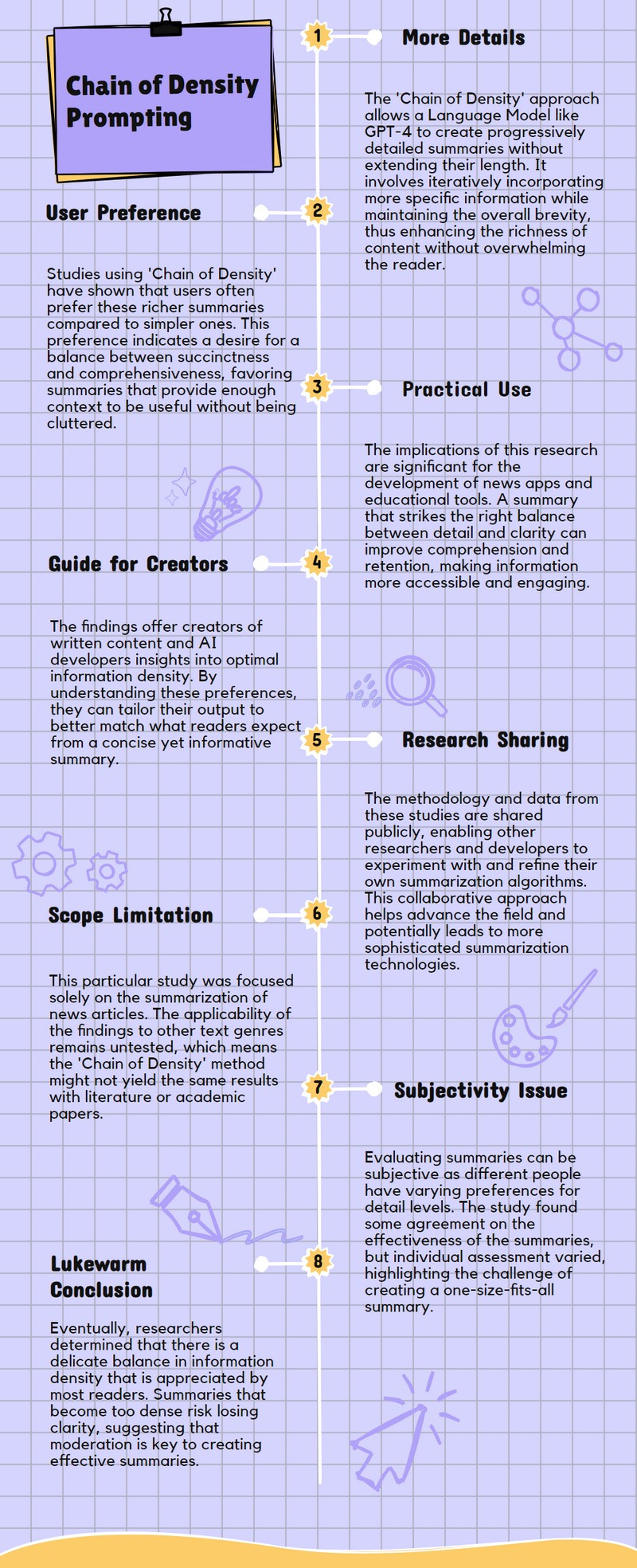From Sparse to Dense: GPT-4 Summarization with Chain of Density Prompting
Prompt engineering series on techniques eliciting reasoning capabilities of LLMs
This is a non-technical explanation of the original paper - From Sparse to Dense: GPT-4 Summarization with Chain of Density Prompting
Abstract
This study explores how to make summaries with just the right amount of detail using a method called 'Chain of Density', where an LLM (GPT-4) creates summaries that get more detailed without getting longer.
People liked these detailed summaries more than simpler ones made by the LLM without this method, showing that finding the balance between information and clarity is key.
Practical Implications
This paper shows that making summaries with just the right amount of detail can help people understand complex news articles better, without feeling overwhelmed by too much information.
By using a method where summaries get more detailed step by step, this research could help in creating better news reading apps or tools that make learning from articles easier for everyone.
The findings suggest that there's a sweet spot in how much information to include in a summary, which could guide writers and AI developers on how to present information clearly and effectively.
Since the study also shares its methods and data, other researchers or developers can use this knowledge to build or improve their own summarization tools, making information more accessible to people.
Methodology
The researchers used a unique approach called 'Chain of Density' (CoD) prompting, where GPT-4 creates summaries that start sparse and become denser by adding important details without making the summary longer.
Chain-of-Density (CoD) prompting starts by creating a basic summary with GPT-4 that includes only a few key details, focusing on being clear but not too packed with information.
Then, in a series of steps, the method adds 1-3 new important details (entities) to the summary without making it longer, which means some parts of the original summary are rewritten to include these new details while keeping the summary concise.
This process of adding details continues, with each step making the summary denser with information but still the same length, aiming to strike a balance between being informative and easy to read.
The goal is to find the right amount of detail that people like in a summary, making it neither too simple nor too complex, by gradually increasing the density of information until it reaches a level similar to what humans would write.
Limitations
The study focused only on news summarization, which means the findings might not apply to other types of text like scientific articles or stories.
Although the researchers noticed some patterns in how the summaries were evaluated, there wasn't a strong agreement among the people checking the summaries, indicating that evaluating summaries can be quite subjective.
GPT-4, the tool used for creating summaries, is not open for everyone to use or modify because its design and inner workings are kept secret by its creators.
Conclusion
The study found that people generally like summaries with a bit more information, but if a summary gets too packed with details, it becomes hard to read and understand.
By adding more details carefully without making the summary longer, the summaries became more useful and interesting, reaching a sweet spot of being informative yet still easy to follow.
However, there's a limit to how much information can be added before the summary starts losing clarity and coherence, showing there's a delicate balance to maintain.
Overall, the research suggests that a moderate increase in the density of information in summaries is preferred, aligning closely with the natural density found in human-written summaries.
How does chain of density prompting technique is different from other prompting techniques?
The Chain of Density (CoD) technique starts with a basic summary and then adds more details step by step without making the summary longer, which is different because it focuses on increasing information density while keeping the summary short.
Unlike other methods that might simply ask for a summary, CoD explicitly encourages adding specific, relevant, and new details at each step, ensuring the summary remains concise and focused on the main story.
CoD summaries become more abstract, show more fusion of ideas, and have less lead bias compared to summaries generated by standard prompts, indicating a unique approach to balancing informativeness and readability.
Paper Infographic


